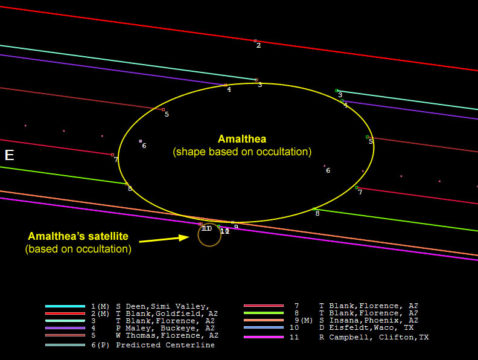On the night of April 13–14, asteroid 113 Amalthea will occult an 11th-magnitude star in Sagittarius.

IOTA / Brad Timerson
Around 7:21 UT April 14th (3:21 a.m. EDT), the 50-km-wide asteroid 113 Amalthea will pass in front of the 11.1-magnitude star TYC 6253-3572-1. The path of visibility, which passes over central New York and New England, is projected to be about 100 km wide. Observers in Buffalo, Rochester, and Albany, as well as those in southern Vermont, New Hampshire, and Maine, should be able to observe the event. Because of prediction uncertainties, Boston may also fall within the range of visibility. The path extends westward to northern South Dakota as well, with the occultation occurring near 7:15 UT (2:15 a.m. CDT) there. However, Amalthea's altitude above the horizon will be very low for those in the west.
Observers in Arizona and Texas found strong evidence for a small satellite of Amalthea during an occultation just over a year ago. During that event, the satellite, whose size may range from 3 to 10 km, was very close to Amalthea as projected in the plane of the sky, probably only a few kilometers separated from the edge of the asteroid. That was probably a fortuitous alignment; most likely, the satellite is in an orbit 50 to 100 km (or more) above Amalthea’s surface. Observers even as many as 200 km north or south of the path are encouraged to watch for a possible occultation by the satellite, which would likely last less than 2 seconds. A central occultation by Amalthea is expected to last 10 seconds with an easily-seen 1.5-magnitude drop.
The star TYC 6253-3572-1 is at RA 17h 45m 37s, Dec. –17° 10′ 08″, in northwestern Sagittarius about 2.5° southeast of 3.5-magnitude Xi (ξ) Serpentis (or about halfway between that star and M23). Finder charts of different scales, small path maps, and other event details are at Steve Preston's Asteroid Occultation Predictions website. A list of times and circumstances for a few hundred observatories and cities, as well as pre-point star lists for eastern New York and eastern New England, can be found here and here.
How to Make and Report Observations
Video or CCD observations are the most useful for events like this, but visual observations, even poorly-timed ones, can be useful for determining the actual path of the occultation. Cell phone apps like Emerald Time or Time the Sat can be used for timing if a short-wave radio for WWV or CHU time signals is not available. More on observing occultations is provided on the observing page for the International Occultation Timing Association (IOTA). For those with astronomical CCDs, the best way to use them for occultations is with a drift scan.
A useful tool for finding asteroid occultations visible near you and for reporting observations is the free IOTA software package Occult Watcher (OW). It includes an interactive Google Map for each event that can used to find a suitable observing site as well as for sharing your intention to observe there. This helps other OW users to avoid duplicating your observations.
If you're able to observe the target star during the expected time (observe for at least a minute before and after the expected time), please send a report of your location, approximate start and stop time of your observation, and how you observed — even if you didn't see an occultation. A "miss" can be as useful as a "hit". If you did witness an occultation, please submit the event times. If you don’t use OW, you can email a report, preferably using the report form available here.
Come Talk to Us!
If you plan to attend this year’s Northeast Astronomy Forum (NEAF) in Suffern, New York, you’re invited to come a day earlier (Friday, April 20th) to attend IOTA’s free annual meeting, open to anyone — see our meeting page for details. Also, please visit us at the IOTA booth at NEAF.
 1
1
Comments
Corey Rueckheim
April 13, 2018 at 6:02 pm
I've always been interesting in contributing to asteroid occultation timings, and to see my data help determine the sizes and shapes of asteroids. I was hoping I could start tonight with Amalthea, as the centerline passes within a mile of my house! Unfortunately, the weather here in Wisconsin is absolutely dismal tonight - the first rain of the year for me. At least it is better than snow!
I wish success to everyone else making the attempt tonight, and I look forward to learning more about Amalthea thanks to all of your data!
You must be logged in to post a comment.
You must be logged in to post a comment.